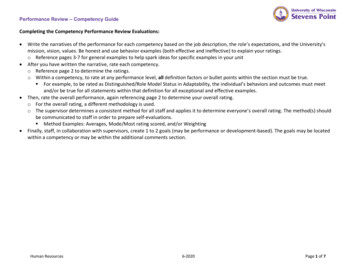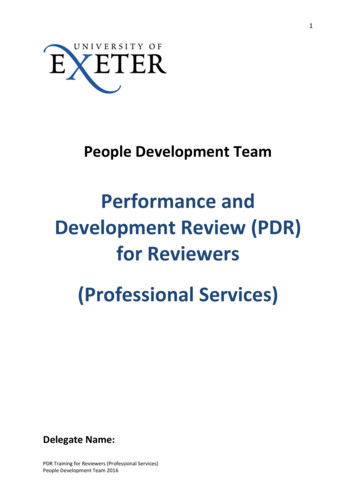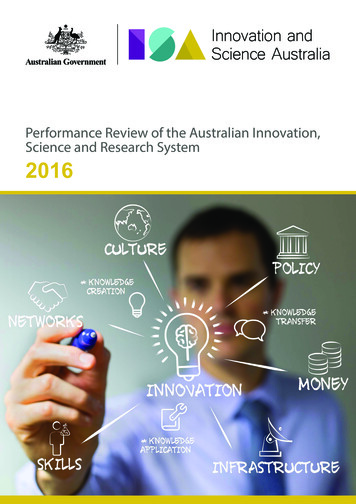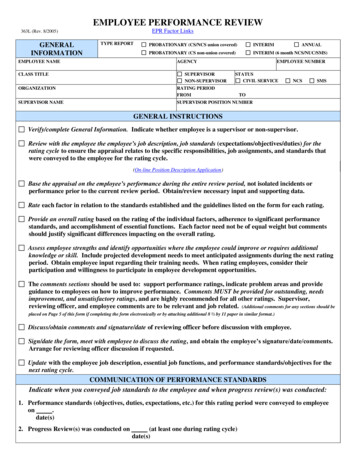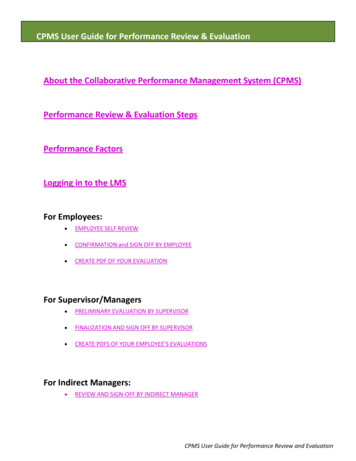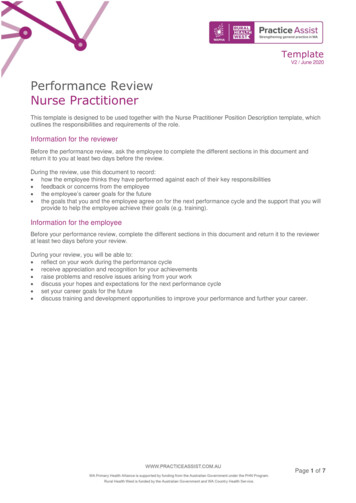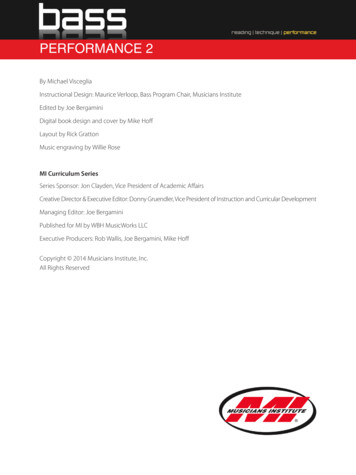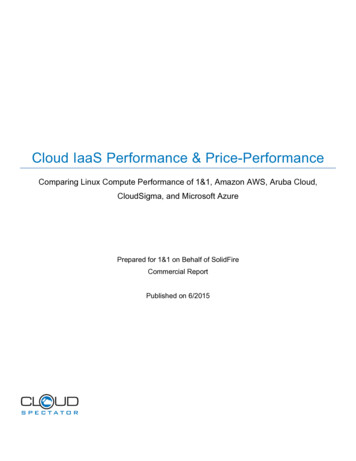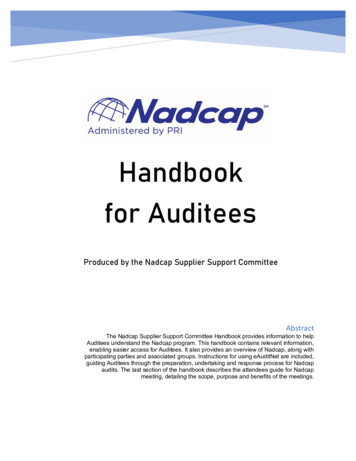
Transcription
Handbookfor AuditeesProduced by the Nadcap Supplier Support CommitteeAbstractThe Nadcap Supplier Support Committee Handbook provides information to helpAuditees understand the Nadcap program. This handbook contains relevant information,enabling easier access for Auditees. It also provides an overview of Nadcap, along withparticipating parties and associated groups. Instructions for using eAuditNet are included,guiding Auditees through the preparation, undertaking and response process for Nadcapaudits. The last section of the handbook describes the attendees guide for Nadcapmeeting, detailing the scope, purpose and benefits of the meetings.
Table of ContentsWhat is Nadcap and How Does it Work?P2Who Participates in the Nadcap Program?P3What Groups Make up the Nadcap Program?P4What is eAuditNet?P7How do I Prepare for an Audit?P9How Does a Nadcap Audit Work?P 15How do I Respond to a Non-Conformance?P 16What Actions are Taken After an Audit is Completed?P 17What is PRI Training?P 18What are Nadcap Supplier Symposia?P 19What is an Attendees Guide?P 20What is the Benefit of a Nadcap Meeting?P 21Nadcap Handbook for Auditees1
What is Nadcap and How Does it Work?The aerospace industry vision is to use Nadcap to develop a global network of world-class Suppliersand Subscribers, who use a cost effective and efficient industry managed accreditation process toensure compliance with global industrial standards and prime requirements as well as to standardizespecial process requirements.This program improves standardization of special processes across the supply chain, whilst reducingthe level of customer audits. Nadcap accreditation can be used as a tool to deliver internal valueadded business improvement along with regulatory compliance. In addition, increased quality levelsgenerally lead to a positive effect on revenue.All participants must comply with the Nadcap personal code of ethics and conflict of interest policywhilst safeguarding the confidentiality of information being shared through the program.Other Performance Review Institute (PRI) programs include: Counterfeit Avoidance Accreditation Program (CAAP): industry effort to mitigate the risk ofintroducing counterfeit parts into the supply chainPRI Training: process, product and personnel improvement via training and membershipeQualified: personnel qualification, developed and managed by industryMedAccred: similar to Nadcap but for the medical devices industryPRI Registrar: ANSI National Accreditation Board (ANAB) approved registrar covering process,product and personnel qualityQualified Products List (QPL): like Nadcap, but focused on products rather than processesTransport and Power Generation (TPG): similar to Nadcap but for the transportation and powergeneration industriesInitially, Nadcap audits are carried out annually, but this may be extended if the Auditee obtains MeritStatus. A company must be registered on eAuditNet to go through the Nadcap audit process.eAuditNet can then be used to obtain the relevant audit procedures, Audit Criteria (formerly calledAudit Checklists) and handbooks, as well as audit planning and correspondence with PRI. NOTE:Some Audit Criteria are available in different languages but are for reference only.Steps in the Nadcap audit process:1. Auditeerequests audit2. Auditscheduled3. Auditorassigned4. Auditcompleted8. Auditeeaccreditation7. Task Groupapproval6. Staff Engineerreview5. Audit findingsaddressedMore information can be found on the following websites: PRI / Nadcap Overview on YouTube.comwww.p-r-i.org: whitepapers, information on meetings, Supplier Support Committee and generaltrainingwww.pri-training.com: professional development, including training and tutorialsNadcap Handbook for Auditees2
www.eAuditNet.com: web-based system developed by PRI covering audits, OperatingProcedures, Audit Criteria, and handbookseAuditNet support is also available by contacting their help desk:Call: 1 724 772 8679Email: eAuditNetsupport@p-r-i.orgWho Participates in the Nadcap Program? Who is Performance Review Institute (PRI)?PRI is a global provider of customer focused solutions designed to improve process and productquality by adding value, reducing total cost and promoting collaboration among stakeholders inindustries where safety and quality are shared goals. PRI, which administers the Nadcap program, isa “not-for-profit” trade association founded in 1990 by SAE International.A Board of Directors leads PRI with responsibility for strategic direction and financial stability. TheBoard is comprised of leading Executives from some of the world’s largest aerospace companies.What are PRI’s responsibilities within the Nadcap program? Schedule audits with qualified Auditors on pre-agreed datesPerform audits on behalf of the Subscribers and submit reports via eAuditNet (Auditors)Review reports and liaise with Auditees to close out any non-conformance(s)Issue Nadcap certificates to Auditees after approval from Task GroupsFacilitate Nadcap meetings around the world and reach consensus on Audit Criteria (AC)Ensure appropriate staffing, including sourcing and onboarding AuditorsAdd value through relevant communication and education including the Nadcap newslettersand free Nadcap technical symposiaWhat is a Subscriber?Subscribers are Nadcap members who have the design authority to write their own special processspecifications and have internal engineering organizations to provide technical directions and support.Subscriber representatives are required to attend Nadcap meetings and are encouraged to becomeactive members with specific Task Group(s).Subscriber voting members review Supplier Audit reports and vote to approve accreditation of eachAuditee. What is a Supplier?A Supplier is an organization that provides special processes for Subscriber’s products, and thatundertakes a Nadcap special process audit based on Nadcap Audit Criteria (AC) and either theircustomer flow-down requirements or new business opportunities to develop their position within themarketplace.Suppliers are required to follow the Nadcap process and participate in undertaking scheduled auditsto the relevant Audit Criteria (AC). They also need to demonstrate through using appropriatedocumentation and hardware, which key parameters and levels are achieved against a standard setof Audit Criteria (AC) questions.Nadcap Handbook for Auditees3
Suppliers can also decide to use the structure of the Audit Criteria as a framework to improveconsistency and standardization within their organizations.What Groups Make up the Nadcap Program? Nadcap Management Council (NMC)The NMC consists of Subscribers and Suppliers, whose role is to speak for the needs of the globalaerospace industry and their organizations in promoting teamwork, facilitating consensus, focusing onquality and ensuring the Nadcap program is robust and representative, from a managementperspective.The NMC members are responsible for: Overseeing the operation of NadcapEstablishing and implementing policies and proceduresCoordinating and developing the Task GroupsIdentifying, developing and deploying improvementsThe NMC also has a number of committees that oversee various projects or aspects: Metrics Committee: this committee monitors the health of the Nadcap program and managesa framework for responding to Task Group and NMC requests for analysis to determine theeffects of proposed strategic initiatives. This is achieved by establishing measurable goals andconsistently reviewing the program’s progress in achieving set goals. In addition to thenecessary data analysis, they also assist the NMC in developing strategic improvements andrecovery plans. Ethics & Appeals Committee: this committee ensures the effectiveness of the Nadcap program,which has formalized a standard Ethics & Appeal process for all program participants. Thecommittee is tasked with finding appropriate resolutions on any appeals that arise through theestablished process. In addition, they also promote awareness of common issues raised bySuppliers and Subscribers. Standardization Committee: this committee is continually reviewing the Nadcap Task Groupfunctions to better understand operational differences and drive changes to bring commonalitybetween Task Groups, when appropriate. The committee regularly assesses best practicesand recommends strategic actions to ensure that all groups can operate efficiently. Oversight Audit Committee: this committee is tasked with overseeing the operation of theNadcap program, verifying that the Nadcap process is being carried out in a way that iscompliant to all procedural documents and continues to achieve its objectives relative tocustomer expectations. Globalization & Strategy Committee: this committee works to develop the future vision forNadcap. It includes development of potential new Task Groups as well as liaising with otherglobal quality programs, all with a goal of continuing to add value to the Nadcap program forall stakeholders. Continuous Improvement Committee: this committee works on initiatives focused on improvingthe overall consistency of the Nadcap program.Nadcap Handbook for Auditees4
Task GroupThe Nadcap audit and accreditation process are overseen and managed by industry. For eachspecial process, product or system audited by Nadcap, there is a Task Group made up of technicalexperts from Nadcap Subscribers and Suppliers. Their role is to speak for the needs of the globalaerospace industry and their organizations in promoting teamwork, facilitating consensus, focusing onquality and ensuring the Nadcap program is robust and representative, from a technical perspective.All Task Group members work together to determine audit requirements, and develop documentssuch as Audit Criteria and training materials. Members work with the Nadcap Management Council tocontinually improve the program.Task Groups make the final decision on Nadcap accreditation, based on the audit report andsubsequent Supplier activities to address any non-conformance(s) identified by the Auditor. Forreasons of confidentiality, only Subscribing members of the Task Group are responsible foraccreditation decisions.Subscriber voting members are members of Nadcap with voting rights in Nadcap Task Groups. Inaddition, each Nadcap Task Group may have one confirmed Supplier member with full votingprivileges per company except on matters pertaining to accreditation.Staff Engineers are members of PRI staff assigned to each Task Group. They facilitate associatedTask Group operations including creating and revising Audit Criteria (AC), reviewing audits, anddispositioning non-conformance responses(NCRs). Each Task Group has one or more StaffEngineers who are the Auditee’s primary contact for help with technical questions regarding the AuditCriteria (AC) and for resolving non-conformance(s) resulting from audits.Audit Reviewers are individuals assigned by PRI staff to each Task Group specifically to review auditreports and be the Auditee’s primary contacts for help in resolving non-conformance(s) resulting fromaudits.Information regarding the Nadcap Task Groups can be found on the PRI website under the Nadcaptab then click Task Groups. In addition, Nadcap Task Group information can be found in eAuditNetunder the Resources tab Documents Public Documents Task Groups.The information listed below can be found on the PRI website, Nadcap AccreditationAudit CriteriaDocumentExamples/SummaryAerospace QualitySystem (AQS)AC7004Used to verify Nadcap Quality Systemrequirements, in conjunction with a separateNadcap auditAero Structure Assembly(ASA)AC7135Aero structure assembly, fastening, electricalbonding of aero structure assemblies andcomponents, bushing and bearing installation andsealing of aerospace assemblies and componentsChemical Processing(CP)AC7108Etching & etch inspection, stripping, cleaning,surface preparation, anodizing, conversioncoatings, plating, solution analysis, etc.Coatings (CT)AC7109Application, examination & processing of thermalspray, vapor deposited & diffusion coatingsComposites (COMP)AC7118Fabrication of composite materialsNadcap Handbook for Auditees5
Conventional Machiningas a Special Process(CMSP)AC7126Holemaking, broaching, turning, milling & hobbing,grinding, and edge treatmentElastomer Seals (SEAL)AC7115Manufacturing of elastomeric components, such asseals, metal to elastomer bonded and textilereinforced components, etc.Electronics (ETG)AC7119AC7120AC7121Printed boards, soldering, coating, programming,assembly, cable & harness assembly, final testing,repackaging, etc.Fluid DistributionSystems (FLU)AC7112AC7123Fluid systems components, hose manufacturing,fittings & other machined components, couplings,assembly, etc.Heat Treating (HT)AC7102Conventional heat treating, brazing, carburizing,nitriding, induction hardening, sintering,hardness/conductivity testing, etc.Materials TestingLaboratories dness/ corrosiontesting, chemical analysis, specimen heat treating,metallography, etc.Measurement &Inspection (M&I)AC7130Coordinate measuring machines, laser tracker,articulating arm, 3D structured light systems, massairflow measurement, etc.Metallic MaterialsManufacturing (MMM)AC7140Forging, i.e. using compressive forces to shapemetals, incorporating pre-& post forging processesNonconventionalMachining (NM)AC7116Electrochemical machining/grinding, electricaldischarge machining, abrasive water jet machining,laser machining/marking, etc.Nondestructive Testing(NDT)AC7114Component inspection using penetrant, magneticparticle, ultrasonic, eddy current, or radiographytechniquesNon Metallic MaterialsManufacturing (NMMM)AC7124Non-metallic components manufactured from resin,prepreg, adhesive films, core, fibers, etc.Non Metallic MaterialsTesting (NMMT)AC7122Physical/chemical/thermal/flammability testing ofnon-metallic materialsSealants (SLT)AC7200AC7202AC7129Accreditation of seali
Nadcap audit Aero Structure Assembly (ASA) AC7135 Aero structure assembly, fastening, electrical bonding of aero structure assemblies and components, bushing and bear ing installation and sealing of aerospace assemblies and components Chemical Processing (CP) AC7108 Etching & etch inspection, stripping, cleaning, surface preparation, anodizing, conversion coatings, plating, solution analysis .




